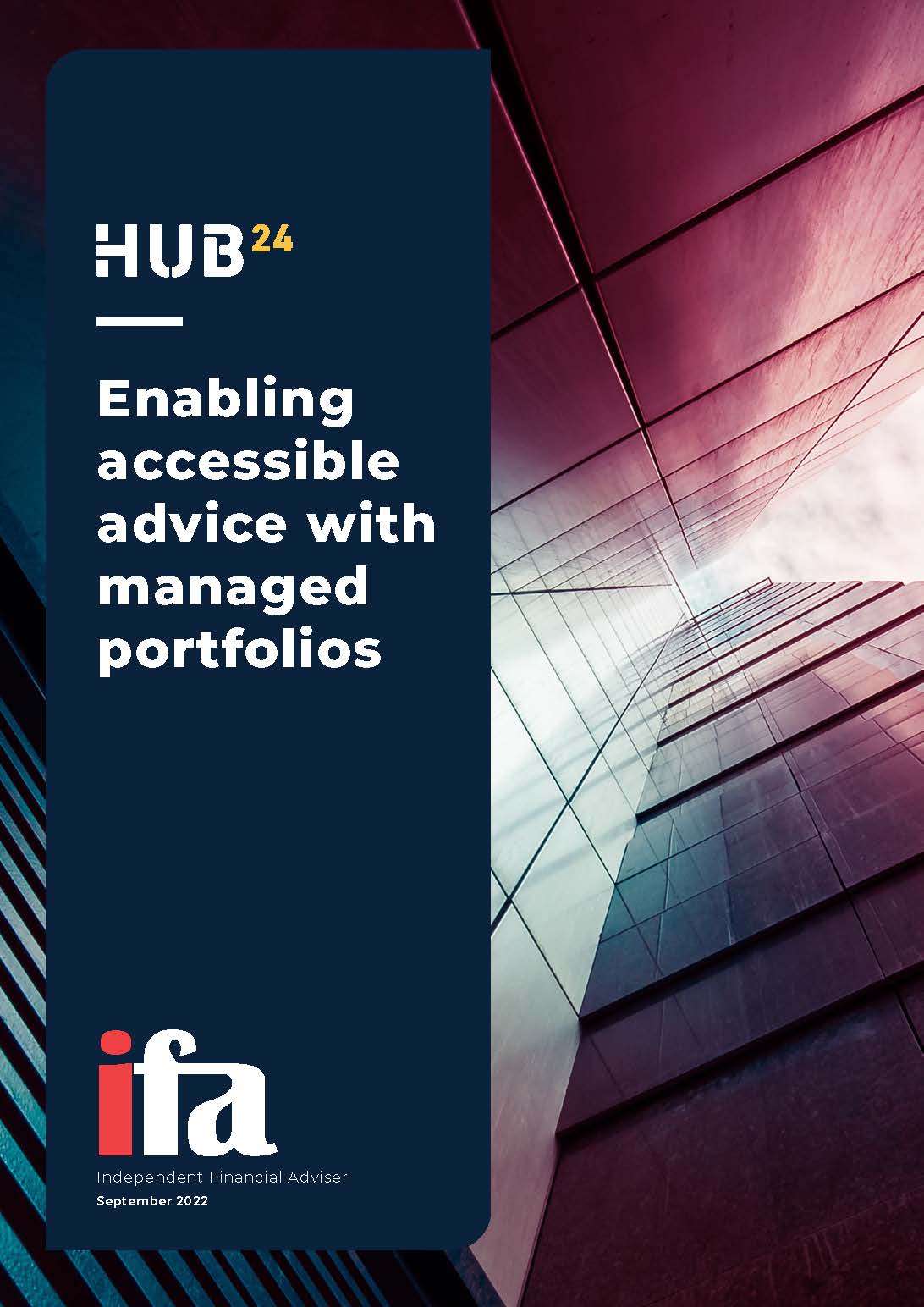In this article
More than half of Australian financial advisers use managed portfolios. From a practice management perspective, managed portfolios deliver significant efficiencies. But what does this really mean for the profession? And how do everyday Australians benefit?
Based on the latest data from the industry research firm, Investment Trends and key insights from industry leaders, this white paper presents a compelling case for managed portfolios playing an integral role in the accessibility and affordability of financial advice.
What are managed portfolios?
A managed portfolio (also known as a managed account, separately managed account (SMA) or managed discretionary account (MDA) is a collection of assets managed on the client’s behalf by a professional portfolio manager, which can be held as part of superannuation, or as an investment. While this concept is not new, managed portfolios offer a range of benefits and efficiencies for clients which cannot be achieved by traditional managed funds.
With technology at their core, managed portfolios can provide advice practices with key business efficiencies while delivering their clients greater transparency, enhanced value and an attractive value proposition.
Widespread adoption
The past 12 months have seen a significant increase in the adoption of managed portfolios among Australian advice practices.1
Investment Trends asked 669 advisers between December 2021 and January 2022 if they have used managed portfolio accounts for their client investments. Over half (53 per cent) currently use them, while 18 per cent plan to do so in the near future. Less than a quarter (23 per cent) have never used managed portfolios and don’t plan to, while only 6 per cent of advisers have used them before and won’t again.
These results suggest that managed portfolios have become a mainstream solution, with more than half of advisers now recommending them to clients.
HUB24 head of managed portfolios, Brett Mennie, believes the key drivers of this widespread adoption are twofold — the ability to meet client objectives and the growing need to create efficiencies in the advice practice to reduce the cost of delivering advice. “Firstly, from a client perspective, many are seeking greater control, flexibility, and transparency of their portfolio. Managed portfolios fit this bill for many clients.”
“Second, running a practice has become increasingly complex and compliance-oriented,” he says. “The cost of delivering advice to clients has gone up. Within their practices, advisers are not only looking to meet their clients’ needs but want to become more efficient in order to reduce the cost of providing advice. Managed portfolios help to solve that challenge by offering clients a suitable option while systemising processes and reducing risk in the advice practice.”
Research from Investment Trends1 shows the time savings of managed portfolios has continued to increase as the solutions mature and proficiency levels rise. Advisers who use managed portfolios say they save 15.7 hours on average in a typical work week, up from 13 hours in 2020. This additional capacity enables managed portfolio account users to direct their time and energy into other areas of their business to better engage with clients.
Overall cost to clients (54 per cent) remains the predominant element driving the preference of a managed accounts platform. Good reporting (39 per cent), range of managed portfolio accounts (37 per cent), and BDM relationship (35 per cent) are also highly valued.1
Making advice accessible
The need for affordable and accessible advice is a hot topic across the industry and was recently highlighted in Solving Wealth’s Greatest Challenge, a documentary jointly produced by XY Adviser and HUB24.2
Looking at the fundamentals, the demand for financial advice is increasing, yet the cost of advice is becoming prohibitive for many Australians. According to Adviser Ratings:3
29% of unadvised Australians are looking to seek help from an adviser
1 in 3 consumers don’t have the capacity to pay for advice
8% increase in the median cost for the initial advice per client to $3,256
3,323 fewer advisers compared to 12 months ago
Combined with the fact that Australia is set to see a $3.5 trillion transfer of wealth to Millennials, Gen Y, and Gen Z over the next two decades,4 the expected demand for advice while managing the cost of advice will remain a challenge for the industry.
As a result, licensees, practice owners, and advisers are looking for ways they can deliver more affordable and accessible solutions for more Australians by creating efficiencies in their practices.
Managed portfolios have the potential to revolutionise the way practices operate. By driving efficiencies through an adviser’s business, they can help manage compliance, reduce fees, and establish an offering that allows a greater number of Australians access to affordable financial advice.
“Managed portfolios have the potential to revolutionise the way practices operate”
Gaining efficiencies and time
Managed portfolios are a well established efficiency tool. Practices that have been using them for years report being able to provide a superior customer experience, better manage their own practice, and avoid spending time on time-consuming tasks and manual processes.
HUB24’s Brett Mennie says that with advisers exiting the industry, some practices will be taking on more clients.
“Increased compliance requirements have created the issue around how to deliver advice effectively and efficiently,” he says. “But we know technology can help practices deliver what was once high-end advice across a broader client base. It can also be used to support the delivery of ‘platform alpha’ or the value that can be unlocked for clients by using enhanced technology.”
Advisers who have adopted managed portfolios are now recommending the solution to the majority of their active client book (60 per cent of active clients, up from 44 per cent in 2021 and 33 per cent in 2019).5
According to Mr Mennie, some practices have up to 90 per cent of their clients in managed portfolios.
“The closer you can get to that full adoption, the more efficiency you’re going to unlock in your practice. As managed portfolios offer a scalable way of meeting clients’ individual needs and preferences, when you have more clients in managed portfolios, the time savings can really add up. In fact, [according to Investment Trends] advisers who use managed portfolios save almost 16 hours a week on average,”6 he says.
Graham Burnard, a senior consultant at Elixir Consulting, works with practices across the country and believes the time-saving benefits of managed portfolios are significant.
Mr Burnard says that while the average number of clients per adviser is going up, those who use managed portfolios spend more time with clients and do less admin work.
“They’re doing less non-productive or non-value add work, so they’re finally having richer conversations with clients. This has been a real enhancement. Add to that the benefit to the client of having speedier implementation.”
“The closer you get to that full adoption, the more efficiency you’re going to unlock in your practice.”

Enhancing your client value propositions
Mr Burnard says one of the most striking benefits of managed portfolios lies in their ability to transform a practice that has yet to nail down its core value propositions.
“It forces advisers to get clarity around their investment philosophy. To pick the right asset consultant and the right product, you have to be really clear. What do you believe? Active versus passive tactical asset allocation, all of these things. And as we know, there’s no right or wrong answer, but as an adviser you’ve got to say, ‘What do I believe, [and] what do I want to have as the solution for clients?’ Then go and find the right people to partner with to build that and stay true to label.”
“Once you’ve got that clarity, it’s easier to articulate to the clients that this is a more efficient way of implementing what we’ve always talked about.”
Melbourne-based financial planner and accountant, Tracey Sofra, agrees that staying true to label is critical. It has been close to two years since Ms Sofra’s practice, Sofra Partners, adopted managed portfolios. The firm decided to use its annual review time to introduce the option to clients.
“You need to ensure that the advice you’re giving is what you’re actually delivering,” she says. “That’s a key point. And it does make you stop and ensure that you, as advisers of that firm, deliver what you believe and are able to communicate that value proposition,” she says.
“Once we presented them with what was possible and they could see the benefits, most of our clients were on board. When they could see the benefits of transferring across, it really wasn’t much of a discussion.”
Mr Mennie concurs that discussing the potential benefits of managed portfolios with clients is key in demonstrating how they may suit the client’s objectives.
“Once you’ve got that clarity, it’s easier to articulate to the clients that this is a more efficient way of implementing what we’ve always talked about.”
“The capabilities regarding tax optimisation, portfolio customisation and diversification, together with transparency are all important discussion points for advisers in educating clients about the product and how it may meet their individual needs.”

Reimagining your skillset
While a shift to managed portfolios can enhance a practice’s client value proposition, it can also prompt advisers to reimagine their own skill set and truly understand what their clients want.
“We resisted managed accounts for a long time,” says Damien Skidmore, founding partner of Sydney-based Private Wealth Partners.
“Our roots are in financial markets. That’s our background. We thought that was our value add and it’s not,” he says.
Private Wealth Partners only started using managed portfolios in the past 12 months. It was a major decision for the practice, which has an MDA license as part of its AFSL.
“We essentially had every client on an MDA, and of course, under that, the client doesn’t have the day-to-day visibility of what you’re doing. They find out throughout the advice process and relationship and that served us really well. But it was an unsustainable model for us,” Mr Skidmore says.
“We started the process of adopting and integrating managed portfolios about 12 months ago and it has been a long road, but we have a much better client narrative now and it’s a far more transparent process for the client.”
“We started the process of adopting and integrating managed portfolios about 12 months ago…it’s a far more transparent process for the client.”
Meeting demand and transitioning clients
While there is work involved with implementing managed portfolios, including SOAs and a migration process, the long-term benefits are clear in terms of clients and advice efficiencies.
Elixir Consulting’s Graham Burnard suggests advisers plan this transition process carefully.
“I’m working with one firm that presents separately managed accounts as an option at review time. Their big challenge is every single client is saying, ‘Yes, I want that’,” he explains.
“So, it’s also often about the transition process of advice delivery and the move to a different platform.
“You’ve got to look at the capacity of the business to do this and sometimes it’s not even 12 months — it might be 18 months or two years to cycle through the full client base and work that through. Having a project plan and a change management plan is what’s critical. Know what you’re dealing with, the time involved, and plan it out.”
Enabling transparency around investment decisions
Practices that use managed portfolios gain an upper hand by clearly explaining their investment philosophy and communicating this to their clients.
Private Wealth Partners is new to managed portfolios, but the firm and its clients are already seeing the benefits.
When economic conditions shifted earlier this year, inflation started to rise and asset prices began falling, the practice saw an opportunity to educate its clients.
“We were able to host a very informal discussion with our head of equities, our head of asset allocation, and myself. We sent it out to clients within an hour,” Mr Skidmore says.
“It wasn’t particularly polished, but that’s what clients want. They want to hear our opinions and our views, what we’re changing behind the scenes, and how that flows through to their portfolios. It’s been a wonderful change so far in terms of that narrative to the client.”
Meanwhile, Sofra Partners’ Tracey Sofra has seen a positive shift in client satisfaction in recent months thanks to managed portfolios.
“For those clients who want to know, we’ve been able to drill down into their particular investments,” she says. “It’s very transparent. You can see exactly where your investments are. In terms of transparency and a client’s ability to become more involved, it’s brilliant compared to a managed fund.
“Managed funds are traditionally opaque, and you don’t have the flexibility. For the particular client that wants to be more involved and is curious around their investments, managed portfolios are brilliant. It allows the conversation to flow, and gives them that sense of ownership where they don’t feel disjointed from their investments.”
Clients and the bigger picture
Advisers can play an important role in educating clients about their investments, with educated clients far more likely to tell others about the value of advice than those with less transparent investments.
If Australia is to make advice more accessible to more people, practitioners must do their part to provide a customer experience worth talking about. If your clients can’t explain what you do for them, who can?
HUB24’s Brett Mennie says there is still a large portion of financial advice clients in Australia that are not across the detail of their investments.
“They may only hear from their adviser during an annual or half yearly review. From the client’s perspective, it could be perceived that their adviser is only working for them at that time,” he says.
“But as any adviser will tell you, that work is happening on a daily basis. The ability to show those investment changes and demonstrate that value is far more engaging than not showing the activity taking place.”
The bigger picture for HUB24 is the role that managed portfolios play in the delivery of real goals-based and strategic financial advice.
“Clients become concerned when markets are volatile. What they want during periods of volatility like we’re seeing at the moment is regular communication with their financial adviser. They want to be informed about what actions are being taken to safeguard their investments.
“Clients really don’t value the administration side of advice. They value conversations about their lives, their retirement goals, and the real issues that are important to them. Managed portfolios are what enables and supports those quality conversations.”
Conclusion
Financial advisers have never spent more time running their business than they do today. In this environment, driving administration efficiencies is essential if we’re going to address the advice gap and drive down the cost of advice.
The power of managed portfolios extends far beyond the benefits to individual clients around managing and understanding their portfolio. They have the potential to enable advisers to take on more clients, reduce their cost to serve, and spend more time focusing on what matters most to their clients

Want to know more?
Find out how HUB24’s market-leading managed portfolios can empower you to add value for your clients and deliver efficiencies for your business.
Disclaimer
IMPORTANT INFORMATION This document has been issued jointly by HUB24 Custodial Services Ltd (ABN 94 073 633 664, AFSL 239 122 (HUB24) and ifa published by Momentum Media Group ABN 92 126 853 085 and is current at the date of issue. HUB24 is the operator of HUB24 Invest (an investor directed portfolio service), promoter and service provider of HUB24 Super which is a regulated superannuation fund. Managed portfolios are available through HUB24 Invest and HUB24 Super.
The information in this document is intended to be general information only and not financial product advice. The views expressed in this document by persons who are not representatives of either HUB24 or IFA are their own, and do not necessarily represent HUB24 or IFA’s views.
Neither HUB24 nor IFA have validated or verified the views expressed in this document, make any representation as to the completeness or reliability of the material in this document, or accept any liability for loss attributable to use of this document, including liability for any statements which are incorrect or misleading. Readers should not rely on the information in this document and should undertake their own investigations and use their own commercial judgment. This document must not be copied or reproduced without the prior written consent of HUB24. © HUB24 2022
1Investment Trends, Managed Accounts Report, January 2022.
2XY Adviser Pty Ltd and HUB24 Custodial Services Pty Ltd.
3Adviser Ratings, Australian Financial Advice Landscape, 2022.
4M Brimble, K Hunt, D Johnson and K MacDonald, Intergenerational Wealth Transfer: The opportunity of Gen X & Y in Australia, 2017; The McCrindle Wealth Transfer Report, 2016.
5Investment Trends, Managed Accounts Report, January 2022
6Investment Trends, Managed Portfolios Report, 2020.




